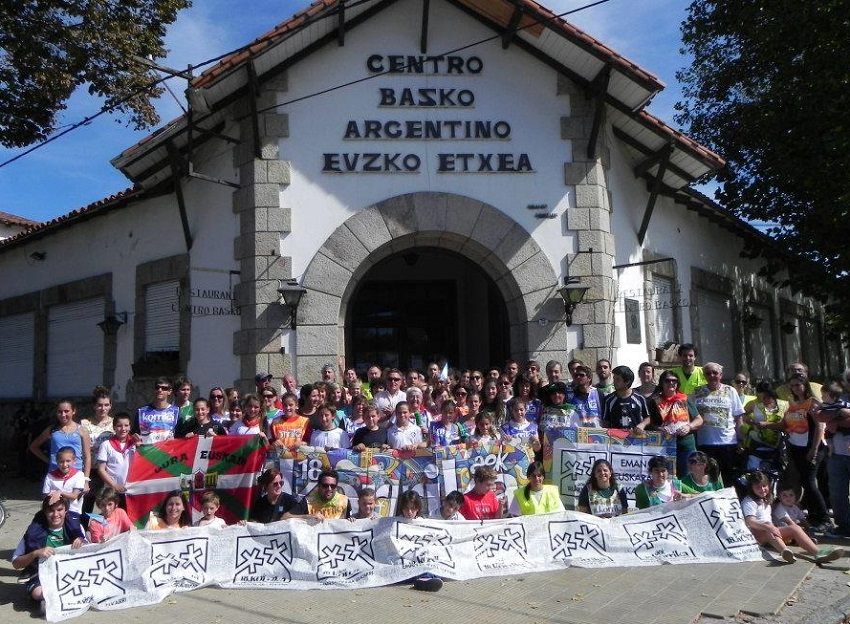Necochea, Argentina. The Euzko Etxea Basque club in Necochea celebrates 70 years today and the board of directors has organized an event at 8pm, and a dinner next Saturday at 9pm in the main hall of the clubhouse. Today’s event will take place in the Basque club’s hall with an unveiling of plaques. In addition there will be traditional dancing. Attending the event will be authorities from the main Basque clubs in the country along with those from FEVA.
Next Saturday, at 9pm, there will be a dinner/dance at the club and tickets are available from the club’s secretary.
Club president, Antonio Alustiza explains, “We will remember the founding of the club. Its activity continues today with its social role and the great participation of a large number of youth that keep the traditions alive.”
The club was founded on April 15, 1945 as a place to gather for the native Basques who arrived en masse in Necochea after the first wave of immigrants at the end of the 19th century and the beginning of the 20th and later after the Spanish Civil War in 1936.
Other historic Basque clubs in the country, besides Necochea, are found in places like Buenos Aires, la Plata, Rosario and Bahia Blanca. “They were meeting places for the Basques who came to this country,” Antonio Alustiza said. Years after the founding of the club, the clubhouse was inaugurated on Avenida 58 and 65th Street.
In the community
“The club has always had a strong relationship with the community in Necochea,” the president said, and emphasized that “the grandchildren and great-great grandchildren of the founding members still participate in club activities.”
Among its activities, he highlights Semana Nacional Vasca that takes place an nually, each year in a different city in the country, and has been always very popular in our city, attracting many people. In addition to a youth conference for local youth and those from abroad.
The Basque also celebrate, along with the sapling of the Tree of Gernika - the city that was bombed by the Germans - which was planted in the Plaza Dardo Rocha, the birth of Basque homeland.
Alustiza emphasized the participation of youth of all ages in the Basque club activities. He added that, “this is a good sign for the future of the club that had different objectives 50 years ago.”
The club also hosts sporting events like pelota, paleta and basketball. In the same way, cultural activities include the dance group from the ages of 2-18, Basque courses and a series of events whose goal is to revive traditions, the celebrations and the cultural customs of the Basque Country.
It also has an exchange program for youth, Hator Hona that over the years has provided youth from the Basque Country the opportunity to come to Necochea as well as youth from Necochea to go to the Basque Country. The program highlights cultural activities including gastronomy, language, dance, music, instruments, and other cultural expressions.
Board of Directors
The current board of directors is comprised of: Antonio Alustiza, president; vice president, Jose Picardi; secretary, Ricardo Esnaola; Treasurer Horacio Giacomini; and sub-treasurer, Sebastian Laborde. The sub-committee of women is chaired by Adriana Bilbao. Alustiza also said that the clubhouse currently is about 3,000 square meters big that they maintain but that they are not planning on any more work there. “Our building is adequate for our needs, and the activities that we carry out,” he said.
.He emphasized the restaurant that is functioning really well and provides income to the institution and also creates movement there.
The club’s first board of directors was; Cleto Garate president; vice president, Juan Bilbao; secretary; Francisco Zubillaga Iturralde; sub-secretary, Alfredo Bilbao; treasurer, Luis Muguerza and sub-treasurer, Pedro Zabala Beitia.
The directors were: Pedro Arozarena, Ignacio Larraza, Leoncio Iriberri and Gregorio Zubillaga.
The Basque club building
The land at Avenida 58 and 65th Street, where the clubhouse was built were purchased in 1945 by Cleto Garate. At that time it included 2,000 square meters.
At the first general assembly in August 1945, it was decided to raise 100,000 pesos for the construction of the building.
The building was constructed between 1946 and 1951. The project head was engineer Juan Lluch and carried out by Carmelo Laino’s business.
(published by Ecos Diarios)






 Send to a friend
Send to a friend Add comment
Add comment








